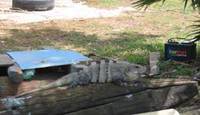March 27, 2005
Isla Mujeres, Mexico. 25-27 March 2005
We are taking refuge from the storm in Isla Mujeres, Mexico. It is only 10 kilometers from the coast of Cancun. The island is 7.5 kilometers long and 500 meters wide. Yesterday the port was closed to maritime traffic because of the bad weather.
In March of 1517 the Spanish expedition of Francisco de Córdova described the island, which was then a sanctuary for the figure of the goddess Ixchel and her entourage, small figures of women, on the island’s beaches. For this reason, the island was known from then on as Isla Mujeres (Island of the Women).

In 1850 more than 250 fishermen, pirates and Mayans fleeing the bloody caste wars came to Isla Mujeres and founded the town Dolores. The creation of the Hacienda Villa Alegre by the Spaniard Fermín Mundana y Marecheaga finalized the status of Isla Mujeres as a human nucleus since it covered 40% of the island’s total surface. This was the point at which agricultural activities and the raising of livestock began.
At the end of the 19th century Isla Mujeres had a population of 651, with a demarcated urban area, where the maritime landscape with its multitude of birds, sailboats and the bustle of fishermen shaped a picturesque view.
Today this romantic landscape has evolved an image common to tourist areas: the main streets of the town are lined with brightly-colored little shops that sell a wide variety of necklaces, bracelets, and earrings on some shelves, while on others are stacked colorful shirts with `Isla Mujeres’ embroidered or glued on, and other souvenirs.
Battered red taxis continually cross the island from one end to the other. The other available forms of transport are rented bicycles, mopeds, or golf carts, which have seating for a maximum of four. Today tourism is the island’s principal source of revenue.
Once we are settled in and before we begin our in-depth cleaning of Ranger we visit the town. In our path on the dock we find a crab the size of a spider crab; it must be a Caribbean spider crab. In the city we discover that the culinary offerings encompass all nationalities – there are French restaurants, Italian restaurants, etc.
The next morning, the path that leads from the boat to the dock showers is full of iguanas of different sizes, rough-bodied, brown and ash-colored, slow. When they notice our presence they try to disappear into whatever crack or cavity they can find. One of them makes us laugh, because in her precipitous attempt at flight she only succeeds in hiding her head and front feet, leaving her chubby body and hind legs outside. She has lost her tail, perhaps in a similar escape attempt, and the new tail looks completely different than the rest of the iguana’s body, the skin smooth and unwrinkled.
Surprisingly we find a horseshoe crab (Limulus poluphemus), green-brown in color, its body some 35 centimeters in the shape of a horseshoe and the long tail more or less the same length, with large spines. Sadly it is dead, although this gives us the opportunity to examine much more closely a species of primitive origin, very similar to now-extinct trilobites. This one is a species very common in Florida, where the horseshoe crabs reproduce en masse on the beaches. They live in shallow waters with sandy bottom, often in areas where algae grow.
The days at Isla Mujeres pass slowly after such dizzying activity. We take advantage of the time to read our email, call our families and edit our growing photography and film archives. When we are ready to leave we start listening to the weather forecasts again, but we are out of luck; we have to wait another day. The weather is so bad that they are not even allowing boats to enter the area. We will have to wait and see what tomorrow brings.

